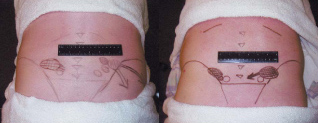Sore Low Back? Look for the Back Mouse
Many people have low back pain. I've noticed with low back pain it's not unusual to find what is sometimes called “The Back Mouse”. The Back Mouse is very common in people who do heavy lifting, sit long hours at a desk, women who are pregnant during and after the pregnancy and all the rest of us too.
Using your fingertips search gently along the pelvic crest (low back along the waist) on either side of the spine. The Back Mouse feels like a soft squishy pad the size of a bean or quarter. There can be many of them or just a few. Sometimes, as pictured above, they can be much larger. And they either hurt when touched, or not.
According to an article by chiropractor W. David Bond for Associated Bodyworkers and Massage Professionals, they're actually fat that has erupted through the fascia layer, (called a Episacroiliac Lipoma) where they kind of sit on top of the fascia in the location where they've come through.
I'd say about half the people I give massage to have one or more of these things. I've had the chance to notice that many people who suffer from low back issues and are already getting massage have never been alerted to their presence. Why is this? It is because The Back Mouse is relatively unknown, and many massage therapists and bodywork professionals do not look for them or notice them when they come across them.
What can we do to get rid of our Back Mouse? The first thing is direct downward pressure during massage is not a good idea. It is contraindicated. So, if you are not yet my client, please tell your present bodyworker or massage therapist to stop massaging them with effluearage, stroking or any downward pressure with force. That will make them worse and possibly cause them to worsen. The Back Mouse can be soothed and eventually coaxed back down under the fascia layer with gentle and persistent lateral treatment. Applying ice is also a good idea.
Over time, the fat eruption can be convinced to recede back under the fascia layer where it belongs. After that, you will have a chance to heal the fascia tear that allowed the Back Mouse to occur in the first place.
Any questions? Just ask.
If you find the sometimes quiet, sometimes demanding Back Mouse residing on your own lower back, call me at 614-431-8814 and I will help you if I can.
Thanks,
Dan Petric, LMT

